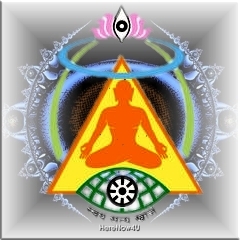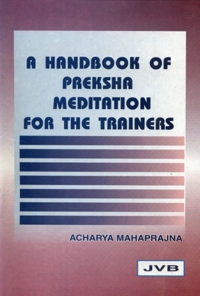
Introduction to be given prior to the exercise:
Kayotsarga may be practiced either standing or sitting or lying down.
For beginners, it is advisable to adopt lying down posture.In standing posture, you have to stand straight with the spine and neck in the straight line but without stiffness.
Keep your feet parallel to each other with a distance of about 10 cms. between them.
Let your arms hang down loosely from the shoulder-joints, close to your body with the palms open facing inwards and fingers straight and pointing down.In sitting posture, you may select a posture of meditation in which you can sit comfortably and steadily for a long period.
The posture of meditation may be full lotus-posture, half lotus-posture, simple cross-legged posture or diamond posture (Vajrasan).
Mudras: Position of Hand
There are two alternatives, one position is called Jnana-Mudra.
Keep your right hand on the right knee and left hand on the left knee, keeping the palms turned up.
Let the tip of the index finger touch the tip of the thumb with a slight pressure between them.
Keep the other fingers straight.The alternate position is called Brahma-Mudra.
Keep both the hands on your lap, one above the other, by keeping the palms up turned.
Let the left palm remain under the right one.
In lying down posture,
lie down on your back on a blanket with your legs slightly apart keeping a distance of about 25-30 cms. between your heels.
Keep your hands along side your body with a distance of about 15 cms. between the palms and the trunk.
Allow your palms to remain open and tuned up.
Be alert when practicing kayotsarga in lying down posture.
First of all see that there is ample space for lying down.
Before starting the actual exercise, stand up and make a resolve for practice of Kayotsarga.
During the exercise of relaxation you have to practice Mula Bandh,
that is contraction of the muscles of your rectum - and relaxing them.
Kayotsarga has two implications:
Complete relaxation of the body and self-awareness.
Complete steadiness of the body is of course essential throughout the exercise.
First step
With folded hands repeat.
I practice Kayotsarga to relieve myself of physical, mental and emotional tension.
Fix the duration of the exercise for 45 minutes.
On completion of this duration, I shall pronounceOm Shanti
[3 times].
Second Step
Stand straight with the spine and neck in straight line but without stiffness.
Keep your feet parallel to each other with a distance of about 10 cms. between them.
Let your arms hang down loosely from shoulder-joints close to your body with the palms open, facing inwards and fingers straight and pointing down.
Taking a deep breath stretch your hand above your head and standing on your toes, create tension by stretching your body fully upward and experience the condition of tension.
Exhale, bring your hands down and relax, and experience the condition of relaxation.
Experience the condition of tension and relaxation alternately three times by repeating the exercise.
Third Step
Now lie down on your back and repeat the exercise which you did in the standing position and experience the condition of tension and relaxation alternately three times by repeating the exercise.
Simultaneously practice Mula Bandh.Now spread out your legs slightly apart keeping the distance of about 25-30 cms. between your heels.
Keep your hands alongside your body with a distance of about 15 cms. between the palm and trunk.
Allow your palms to remain open and turned up.
Keep your eyes softly closed.
Now keep your body completely motionless.
This is very essential.
Slow down the breath, keeping the body completely steady and motionless.Now try to experience that each part of your body including your limbs are becoming as heavy as lead.... [1 minute]
Now experience that each part of your body is becoming as light as cotton... [2 minutes]
Starting with the big toe of your right foot concentrate your mind on it.
Allow your mind to spread throughout the big toe.
Suggest to the muscles and nerves to relax 'Relax....Relax....Relax.....'
Experience that they are relaxing.
Experience that they have become relaxed.
In the same way attain relaxation of the other part of the right leg - the other toes, sole, heel, ankle, upper part of the foot, calf muscles, knee, thigh, upto the hip-joint.
In the same way relax the left limb upto the hip-joint.
Experience that the whole of the lower portion of the body has become completely relaxed.Now achieve the relaxation of the middle portion of the body from the waist upto the neck.
Concentrate your mind on each part one by one, starting with the lower abdomen, relax the front, the back, the right side, the left side, the outside and the inside of your lower abdomen.
Now through your navel, enter the abdominal cavity and relax the large intestine, the small intestine, the kidneys, the spleen, the liver, the pancreas, the stomach and the diaphragm.
Use auto-suggestion and achieve relaxation.
Then concentrate your mind on the chest and relax the entire ribcage beginning with the lowest rib, relax each and every rib in turn.
Relax the right ribs and the left ribs.
Now enter the chest and relax the right lung, the left lung and the heart by autosuggestion(Those who have got any heart trouble should pause here for a few minutes and by autosuggestion, slow down the heart to remove stress.)
Then concentrate your mind on both the hands and arms one by one, starting from the thumb, the fingers, the palms, the wrist, the lower arm, the elbow, the upper arm and the shoulder.
Now achieve the relaxation of the neck muscles in the front and in the back.Experience that the whole of middle portion of your body has become completely relaxed.
Now achieve the relaxation of the upper portion of the body from throat upto the head.
Now we come to a little more difficult part of the exercise. So far you were relaxing large muscles which respond quickly to your suggestion. But now we have to relax a large number of small and tiny muscles which are difficult to relax.
First unclench your teeth and unlock your jaws and let your tongue go limp.
Keep your lips softly closed.
Now relax all the facial muscles beginning with the chin, the lips, the inner portion of the mouth including the teeth, the gums, the palate and the tongue, vocal cords; then the cheeks, the nose, the ears and the temples, both the eyes, the forehead and the scalp.
Through autosuggestion achieve relaxation.Experience that the whole of your upper portion of the body has become completely relaxed.
Again allow your mind to travel from the head upto the feet and from the feet upto the head, this time rather quickly and see that there is no tension anywhere in the body.
Experience lightness in every part of the body.
The whole body from the feet upto the head has become completely relaxed.
Remain completely aware of each and every part of the body.
Now experience that your body is surrounded by a flow of bright white light.
Allow your body to flow in the white stream.
Allow your body to let go.
Experience that your, body is floating like a straw.Experience complete detachment to the body.
Experience peace in each and every point of your consciousness.
Fourth Step
Allow your muscles and nerves to come back to the normal state of working by allowing your mind and vital energy to go over each part of the body from head to the feet and using slow and deep breathing.
Actually experience each part of the body is becoming active.
Conclude the exercise by three long breaths.Om Shanti
Come back slowly to the posture of sitting.
Repeat the aphorism of taking refuge... [3 times]Repeat
Vande Sachcham... [3 times].

 Acharya Mahaprajna
Acharya Mahaprajna

